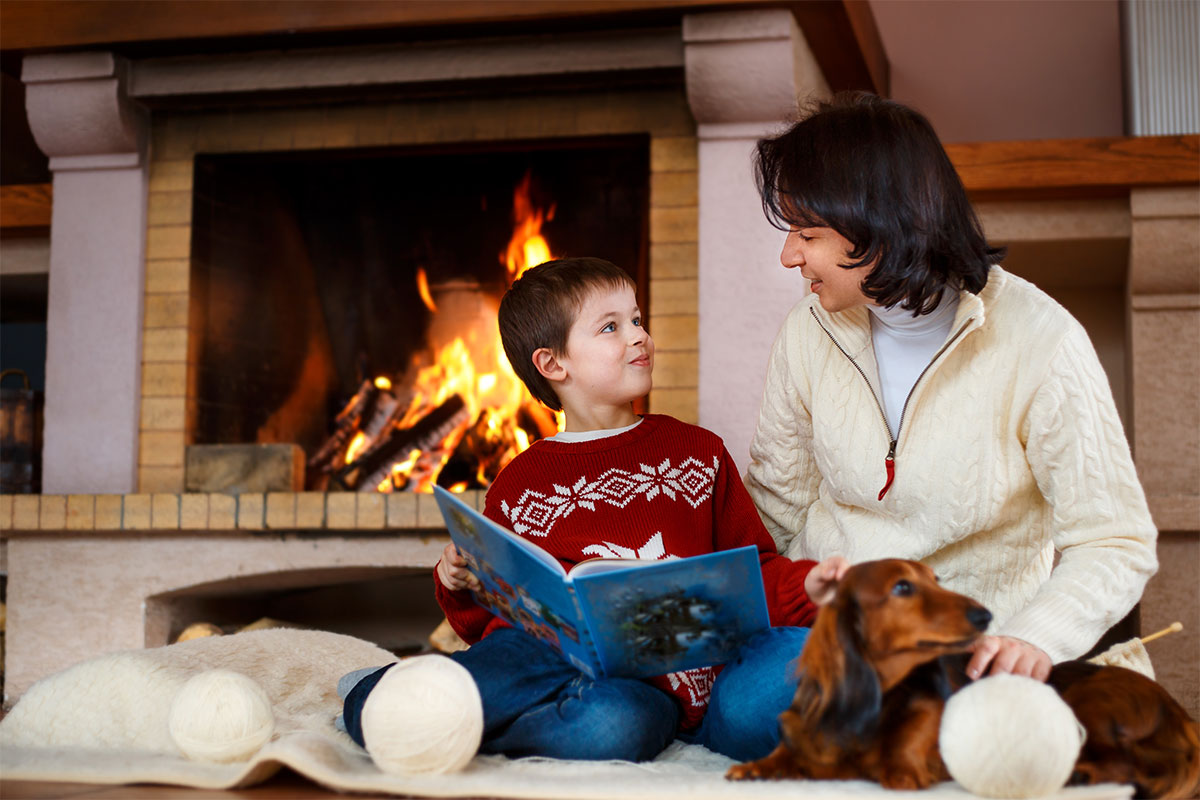The days are getting shorter and the nights are getting colder as Autumn inches closer to Winter. To ward off the chill of these cold damp November nights in Columbus, you’ll be feeling the urge to build a roaring fire in your fireplace while the family is gathered around. You don’t have to be a certified Eagle Scout™ to just throw a few logs into the fireplace and light ‘er up. However, if you’d like to build a longer-lasting, low maintenance, heat producing fire (and not burn the house down in the process) consider this checklist of fireplace best practices.
Start with a Clean Chimney
Just like having your furnace serviced before you use it for the first time each heating season, you should have your chimney cleaned by a professional. It’s a real safety issue: squirrels or birds can build nests, you can have debris enter from the top, and if you actually use your fireplace, there could be a buildup of creosote. Creosote is a tar-like substance that accumulates on the inner walls of a home’s chimney. If it’s allowed to accumulate excessively, it can cause fires. Dangerous house fires. Call that chimney sweep first!Prep Your Supplies
Assuming the chimney cleaning is out of the way (you did call a chimney service, right?), let’s gather everything we’ll need before we start to build the perfect fire.- Logs in a variety of sizes. We recommend hardwood for longer burning times. Be sure the logs are seasoned (dried) and ready to burn. The less bark, the less “popping” you’ll get. Unseasoned wood contains sap that also pops and cracks, but adds to dangerous creosote buildup in the chimney.
- Twigs, small branches and other kindling to help start the fire.
- Newspaper, craft paper or paper grocery bags. If you’re like us, we no longer subscribe to a newspaper. But we did discover a great resource: the family shredder! Grab some of that waste shredded paper and have it nearby. Alternately, if you recycle paper, you can opt for clean and dry recycled copy paper.
- Fireplace grate to hold the logs
- Fireplace screen for protection from stray sparks
- Fireplace tool set, at the minimum a poker and tongs. Later, you’ll need a shovel and brush for cleanup.
- Long fireplace wood matches or a refillable butane lighter.
- Fire extinguisher. Because you never know…
Check the Damper
Unless you wish to fill your house with smoke, open the damper first. Hopefully your chimney inspection included getting it cleaned so it’s easy to open.The Magic is in How You Stack the Logs
Start with a teepee style stack of kindling, followed by progressively larger pieces of log. For a good, even burn, you need dry wood with plenty of space to allow oxygen between, so don’t pack it in tightly. Build about 2-3 layers, with each layer perpendicular to the previous layer. It’s a good idea to add a few pieces of smaller wood/kindling between each layer to help the fire accelerate and add spacing. Don’t put logs that are very large onto the pile, unless you intend for the fire to burn for a long time. Finish off the top with a few more pieces of kindling. Be sure the stack is stable and no logs will roll out of the fireplace once it’s lit! Also, if you leave a bit of a gap in the center of the pile all the way to the top, that gap will act like a chimney and funnel oxygen to burn the flame. Tear the newspaper into long ½ to 1 inch wide strips, wad them up, then build a generous pile beneath the grate directly under the kindling. If you’re using shredded office paper, you can skip this step, the shredder’s already done the hard work for you!C’mon Baby Light My Fire
Now it’s time to light the newspaper beneath the kindling. If you’ve followed the previous steps, you won’t have to resort to “blowing” air to get the fire started! (We don’t really recommend that). Sit back and watch as the lit newspaper/shredded paper does its magic and catches the kindling, and eventually the logs, on fire. If you build the stack correctly, the logs act as sort of a self-burning chimney by funneling oxygen up the center of the fire, causing it to burn more consistently.Fireplace Dont’s & Safety Tips
- Depending on how much fuel you put on your initial pile, you can probably let the fire burn on its own until it goes out naturally. Check the temperature by holding your hand near the ashes after all the wood is burned. You may still feel some warmth, but it should be cool enough to not re-ignite a fire. If there is still fuel (wood) in the fireplace, you can scatter the embers with a poker and they’ll cool a bit faster. As a matter of fact, it’s a good idea to stir those embers and spread them out inside the fireplace anyway.
- If your fireplace has a screen and glass door, you can safely close the door to remove the fire’s source of oxygen to let it extinguish on its own. Do NOT shut the flue until the embers are completely cool.
- Don’t try to remove the ashes before the next day. And have a metal ash bucket with a lid or other similar container to remove the ashes. (A friend of mine once emptied his fireplace ashes the next morning into a plastic bucket sitting on the carpet… but he didn’t notice they were still smoldering a bit, and proceeded to melt the bucket bottom and burn a circle into the carpet. He could have easily burned the house down had he not returned soon after to find the mess!)
- Keep a metal bucket with play sand nearby to mix with the embers/ashes to ensure they’re completely extinguished. You should leave the ashes in the fireplace for at least 24 hours after the last fire to ensure they are cool enough to handle.






